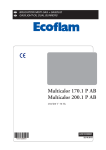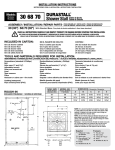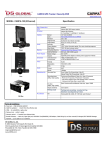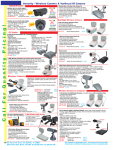Download Samsung SBC-300AP User guide
Transcript
User Guide CAUTION RISK OF ELECTRIC SHOCK, DO NOT OPEN CAUTION : TO REDUCE THE RISK OF ELECTRIC SHOCK, DO NOT REMOVE COVER (OR BACK). NO USER-SERVICEABLE PARTS INSIDE. REFER SERVICING TO QUALIFIED SERVICE PERSONNEL. The lightning flash, with an arrowhead symbol, within an equilateral triangle, is intended to alert the user to the presence of uninsulated “dangerous voltage” within the product’s enclosure, that may be of sufficient magnitude to constitute a risk of electric shock to persons. The exclamation point within an equilateral triangle is intended to alert the user to the presence of important operating and maintenance (servicing) instruction in the literature accompanying the appliance. WARNING : TO PREVENT FIRE OR SHOCK HAZARD, DO NOT EXPOSE THIS APPLIANCE TO RAIN OR MOISTURE. User Guide 1. Read all of these instructions. 2. Save these instruction for later use. 3. Unplug this appliance system from the wall outlet before cleaning Do not use liquid cleaners or aerosol cleaner. Use a damp cloth for cleaning. 4. Do not use attachments not recommended by the appliance manufacturer, as they may cause hazards. 5. Do not use this appliance near water for example, near a bathtub, washbowl, kitchen sink, laundry tub, in a wet basement, or near a swimming pool, etc. 6. Do not place this appliance on an unstable cart, stand, or table. The appliance may fall causing serious injury to a child or adult, and serious damage to the appliance. Use only with a cart or stand recommended by the manufacturer’s instructions, and use a mounting kit approved by the manufacturer. An appliance and cart combination should be moved with care. Quick stops, excessive force, and uneven surfaces may cause the appliance and cart combination to overturn. IMPORTANT SAFEGUARDS i ii User Guide 7. Slots and openings in the cabinet on the back or bottom are provided for ventilation, to insure reliable operation of the appliance, and to protect from overheating. These openings should never be blocked by placing the appliance on a bed, sofa, rug or other similar surfaces. This appliance should never be placed near or over a radiator or heat register. This appliance should not be place in a built-in installation such as a bookcase, unless proper ventilation is provided. 8. This appliance should be operated only from the type of power source indicated on the marking label. If you are not sure of the type of power supplied to your home, consult your dealer or local power company. 9. Do not allow anything to rest on the power cord. Do not locate this appliance where the cord will be abused by people walking on it. 10. Do not overload wall outlets and extension cords, as this can result in fire or electric shock. 11. Follow all warnings and instructions marked on the appliance. 12. Do not attempt to service this appliance yourself, as opening or removing covers may expose you to dangerous voltage or other hazards. Refer all servicing to qualified service personnel. iii User Guide 13. Unplug this appliance from the wall outlet and refer servicing to qualified service personnel under the following conditions: a. When the power cord or plug is damaged or frayed. b. If liquid has been spilled into the appliance. c. If the appliance does not operate normally by following the operating instructions. Adjust only those controls that are covered by the operating instructions, as improper adjustment of other controls may result in damage and will often require extensive work by a qualified technician to restore the appliance to normal operation. d. If the appliance has been exposed to rain or water. e. If the appliance has been dropped or the cabinet has been damaged. f. When the appliance exhibits a distinct change in performance this indicates a need for service. 14. When replacement parts are required, be sure the service technician has used replacement parts specified by the manufacturer that have the same characteristics as the original part. Unauthorized substitutions may result in fire, electric shock, or other hazards. 15. Upon completion of any service or repairs to the appliance, ask the service technician to perform routine safety checks to determine that the appliance is in safe operating condition. iv User Guide Contents User Guide 1. Introduction 1. Introduction ............................................ 2 2. Features .................................................. 3 3. Installation .............................................. 4 Precautions in Installation and Use ................... 4 Connecting Auto Iris Lens Connector ................ 5 Mounting Lens .................................................. 6 Setting Lens Selection Switch ........................... 7 Adjusting Back Focus ....................................... 8 Connecting Cable ........................................... 10 4. Names and Functions of Parts ........... 13 Names and Functions of Parts ........................ 13 Function Switches .............................................16 Samsung CCTV B/W Camera (SBC-330A(P) /331A(P)/300AP/301AP) is a surveillance camera that employs the latest CCD technology and can be connected to a CCTV system to provide the best surveillance capabilities. Broadcast System SBC-330A/331A SBC-330AP/331AP/300AP/301AP : EIA : CCIR Number of CCD pixels SBC-330A SBC-331A SBC-330AP/300AP SBC-331AP/301AP : 1/3" 27 megapixel (Normal) : 1/3" 41 megapixel (Hi-Band) : 1/3" 32 megapixel (Normal) : 1/3" 47 megapixel (Hi-Band) 5. Product Specification .......................... 19 Power Supply System SBC-330A(P)/331A(P) SBC-300AP/301AP 1 : AC 24V , DC12V : AC 220V~240V 2 User Guide 2. Features User Guide 3. Installation Precautions in Installation and Use High Sensitivity Adopting the 1/3" Super HAD CCD that has the latest built-in microchip lens, the high sensitivity is realized. ➀ Do not attempt to disassemble the camera yourself. ② Be cautious in handling the camera. Avoid Excellent Back Light Compensation The built-in backlight compensation (BLC) function provides a clear, sharp image even when monitoring strongly backlit subjects. striking or shaking the camera. Be cautious to avoid damage on the camera caused by improper storage or operation. ➂ Do not expose this camera to rain or moisture. Do not operate this camera on a wet place. Digital Line-lock ➃ Do not use strong or abrasive detergents when The control and reliability has been enhanced due to the Full Digital Line Lock, which allows users to adjust the Line Sync Phase. cleaning the camera body. Use a dry cloth to clean the camera. ➄ Keep the camera at a cool place away from the direct sunlight. Leaving it under the direct sunlight may result in the malfunction of the unit. 3 4 User Guide Connecting Auto Iris Lens Connector Prepare the following Auto Iris Lens Connector supplied with the camera. Rib Pin3 Pin1 User Guide Mounting the Lens Loosen a screw fixing the Flange Back Adjustment Ring by turning it counterclockwise and turn the Adjustment Ring to the "C" direction (counterclockwise) until it stops. Failure to do so may result in a damage caused by the bump of the lens against the image sensor part in the camera when mounting the lens. Pin4 Pin2 C Direction Connect the cable of the control cable, whose covering is stripped, to the Auto Iris Lens Connector as shown below. Pin Number DC Control Type Video Control Type 1 Damp(-) Power Source (+9V) 2 Damp(+) Not used 3 Drive(+) Video Signal 4 Drive(-) GND VID EO DC LEN S Auto Iris Control Cable 5 6 User Guide Setting Lens Selection Switch When lens mounting is completed, set the Lens selection Switch on the rear of the camera according to the mounted lens type. When the mounted lens is an Auto Iris Lens of the DC control type, set the Lens Selection Switch to "DC". When the mounted lens is an Auto Iris Lens of the Video control type, set the Lens Selection Switch to "VIDEO". User Guide Adjusting Back Focus Although the Back Focus of the camera has been adjusted in the factory before its shipment, the focus may not be accurate for a certain type of the lens. In this case, follow the procedures below to adjust the Back Focus. First, following is how to adjust the Back Focus of the Fixed Focus Lens. ➀ Lightly loosen the screw fixing the Back Focus Adjustment Ring using a screwdriver. ② Image a vivid subject (with check patterns) at a distance of more than 10m away and turn the Focus Ring to the infinity (∞) position. ➂ Adjust the Back Focus Adjustment Ring to obtain the clearest image of the subject. ➃ Fasten the screw fixing the Back Focus Adjustment Ring. O VIDE LENS DC 7 8 User Guide The following describes how to adjust the Back Focus when using a Zoom lens. ➀ Lightly loosen the screw fixing the Back Focus Adjustment Ring using a screwdriver. ② Image a vivid subject (with check patterns) at a distance of 3~5m away and adjust the zoom of the lens to TELE as far as it goes. Then adjust the Focus Ring of the lens to obtain the clearest image of the subject. ➂ Adjust the zoom of the lens to WIDE as far as it User Guide Connecting Cable After mounting the lens and setting the Lens Selection Switch, connect the prepared cable to each terminal of the camera. ➀ First, connect one end of the BNC cable to the Video Output Terminal (VIDEO OUT) of the camera. ② Then connect the other end of the BNC cable to goes. Then turn the Back Focus Ring of the camera to obtain the clearest image of the subject. the Video Input Terminal of the monitor. ➃ Repeat no. ② & ➂ 2~3 times to exactly coincide the zoom focus from TELE and with that from WIDE. ➄ Fasten the screw fixing the Back Focus Adjustment Ring. VIDEO LINE AUDIO LINE Video A Video B Video C IN IN IN OUT OUT A B C IN OUT OUT Video In Terminal on the rear of the monitor O VIDE LENS DC EO VID LENS DC BNC Cable Note: Turning the Back Focus Adjustment Ring to the "C" direction beyond the adjustable range makes a sound at the limit. 9 Video Out Terminal (VIDEO OUT) 10 User Guide ➂ AC24V/DC12V Power Input Camera. Connect 2 lines of the power adapter using a Phillips screwdriver to the Power IN Terminal of the camera as shown below. User Guide AC230V Power Input Camera Connect the power input cord to the AC 230V power source. ※ Without the distinction of the polarity, connect to the AC 24V or AC 12V power source. EO VID DC EO VID S LEN DC AC24V DC12V 11 12 S LEN User Guide 4. Names and Functions of Parts Names and Functions of Parts • Side View User Guide Auto Iris Lens Connector Used for supplying power, which is required to control the iris of the lens, as well as control signal, video signal, or DC signal to the Auto Iris Control Lens. Auto Iris Lens Control Cable Groove for Mount Adapter Auto lris Lens Connector Flange-Back Adjustment Ring Auto Iris Lens Used for transmitting the control signals to the camera to control the iris of the lens. Flange-Back Adjustment Ring Used for adjusting the Back Focus. VID EO DC ALC Lens Selection Switch LEN S Used when selecting the type of Auto Iris Lens to use. DC : Select this switch to DC when Iris Lens requiring DC control signal is mounted. ALC Lens Selection Switch Auto Iris Lens Control Cable Groove for Mount Adapter VIDEO : Select this switch to VIDEO when Auto Iris Lens requiring VIDEO control signal is mounted. Use this groove for fixing the mount adapter to be connected to the bracket with screws to mount the camera on the bracket. Auto Iris Lens (Option) Lens to be mounted on the camera Note When the surface of the camera lens is contaminated, wipe the surface gently with a tissue for lens or a cotton cloth applied with ethanol. 13 14 User Guide User Guide ➀ Power Connection Terminal • Rear Panel Terminal to be connected to the power (adapter) cable- Connect it to AC 24V or DC 12V. AC24V/DC12V Power Input Camera ➁ Power Indication LED While the power is properly supplied to the camera, the LED is turn on. ③ V-Phase Control 5 6 In the Line Lock mode (SYNC LL), use a tool such as a screwdriver to adjust the vertical sync phase. PWR AC 24V DC 12V VIDEO OUT ④ Function Switches 1 AC230V Power Input Camera 1. L/L 3. ELC 2. BLC 4. AGC ON SW1 15 SW2 SW3 SW4 16 User Guide 1) SW1(L/L): If this switch is set to OFF, the camera will operate in the internal synchronization mode, and if the switch is set to ON, the camera will operate in the line lock mode. If you are monitoring in the automatic switching mode with multiple cameras connected to a sequential switcher, and the cameras are set to INT (internal synchronization) mode, then picture rolling or flickering will occur during switching from one camera to another. Such picture rolling on the monitor can be remedied by setting this switch to ON and then adjusting the vertical sync phase with the V-Phase Control. ※ When using DC 12V power, set the L/L switch to OFF. If the L/L switch is set to ON, the camera will not operate normally. 2) SW2(BLC): This switch turns on or off the back light compensation (BLC) function. When there is a spotlight or strong light from behind the subject, the subject may appear dark on the monitor. In such backlighting conditions, set this switch to ON for clear viewing. 17 User Guide 3) SW2 (ELC): Use this switch with the Manual Iris Lens. While this switch is ON, the speed of the electronic shutter varies with the brightness of the subject from 1/60 to 1/100,000 sec for automatically controlling the brightness of the screen. However, with the Auto Iris Lens (DC or Video Control), be sure to switch OFF. 4) SW4(AGC): This switch turns on or off the automatic gain control (AGC) function, which is a function that automatically increases the camera's sensitivity when ambient light drops below a preset level. Set this switch to ON to automatically adjust the "gain". ⑤ DC Iris Level Control When the ALC Lens Selection Switch is set to DC, adjust this Iris Level Control using an adjustment rod such as a screwdriver. ➅ Video Output Terminal This is a terminal to be connected to the Input Terminal of the monitor. Through this terminal, the video signals are output. 18 User Guide User Guide 5. Product Specifications SBC-330A/331A ALC /ELC Item DC IRIS LENS Contents Product Type CCTV B/W Camera Broadcasting EIA STANDARD SYSTEM VIDEO LENS ELC Electronic SHUTTER IRIS function System CCD 1/3” IT type S-HAD CCD No. of Pixel 330A : 510(H) x 492(V) 331A : 768(H) x 494(V) Scanning Type Frequency INTERNAL : 15,750 HZ(H) LINE LOCK :15,750 HZ(H) 60 HZ(V) INTERNAL LINE LOCK(When AC24V power source is used) Resolution Video Output COMPOSITE VIDEO OUT Power Source AC24V±10%(60Hz±0.1Hz) 1V p_p 75 Ω/BNC DC12V+10%-5% 525 Line, 2:1 Interlace 60 HZ(V) Syne Type ALC Power Consumption Operating S/N Ratio more than 50dB Min. Object 0.1 Lux F1.2 (50 IRE) -10℃~+50℃ Temperature Operating Humidity ~90% Size 65(W) x 52(H) x 133(L)mm Weight About 420g Altitude Below 3000m (BNC included) 330A : 380TV Lines 331A: 550TV Lines About 2 Watts Illumination 19 20 User Guide User Guide ALC /ELC DC IRIS LENS SBC-330AP/331AP/300AP/301AP Item Product Type Broadcasting VIDEO LENS ELC Contents Electronic SHUTTER IRIS function CCTV B/W Camera CCIR STANDARD SYSTEM Video Output COMPOSITE VIDEO OUT Power Source 300AP/301AP 1V p_p 75 Ω/BNC System CCD 1/3” IT type S-HAD CCD No. of Pixel 330AP/300AP : 500(H) x 582(V) AC220V~240V±10%(50Hz±0.1Hz) 330AP/331AP 331AP/301AP : 752(H) x 582(V) Scanning Type 625 Line, 2:1 Interlace Frequency INTERNAL : 15,625 HZ(H) 50 HZ(V) LINE LOCK :15,625 HZ(H) 50 HZ(V) Syne Type INTERNAL LINE LOCK(When AC power source is used) Resolution 330AP/300AP : 380TV Lines 331AP/301AP: 550TV Lines S/N Ratio Min. Object AC24V±10%(50Hz±0.1Hz) DC12V+10%-5% Power Consumption 300AP/301AP: About 3 Watts 330AP/331AP: About 2 Watts Operating -10℃~+50℃ Temperature Operating Humidity Size ~90% 65(W) x 52(H) x 133(L)mm (BNC included) more than 50dB 0.1 Lux F1.2 (50 IRE) ALC Weight 300AP/301AP : About 520g 330AP/331AP : About 420g Illumination Altitude 21 Below 3000m 22 Digital B/W Camera SBC-330A / 330AP SBC-331A / 331AP SBC-300AP / 301AP User Guide Part No.: AB68-00346A (Rev. 01) Printed in Korea























